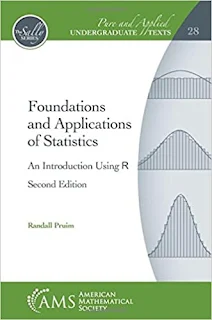Straightforward Statistics with Excel 2nd Edition
Chieh-Chen Bowen ... 520 pages - Language: English - Publisher: SAGE Publications; 2nd edition (October, 2021).
Written in an accessible and clear manner, Straightforward Statistics with Excel® 2e by Chieh-Chen Bowen helps students across the social and behavioral sciences gradually build their skills to develop a better understanding of the world around them. Each chapter purposefully connects with the previous chapter for a gradual accrual of knowledge from simple to more complex concepts. This effective, cumulative approach to statistics through logical transitions eases students into statistics and prepares them for success in more advanced quantitative coursework and their own research. The second edition now features Excel instructions and exercises throughout so students can use this widely-available and applied software for statistics.
This book is designed to walk the reader through statistics at a steady but gentle pace, providing pop quizzes throughout every chapter so readers can check their knowledge along the way. By gradually stepping up difficulty in each chapter, students generate a solid foundation and are prepared for the next chapters. Straightforward Statistics with Excel looks at the big picture so that the basic statistical concepts connect to everyday and relevant research examples in multiple ways. Throughout the book the reader is reminded of what they need to be able to recall with "You Must Remember This" boxes. A rich source of practical resources are located at the end of chapters beginning with " What You Learned," followed by three sets of exercises so students can immediately apply their knowledge. The new edition features a reorganized presentation of material, starting with measures of central tendency, separating this from measures of variability so students better understand the differences. A more thorough presentation of one-sample and dependent samples t-tests gives students a stronger foundation in these crucial tests in statistics. New examples and studies complete the update, with a focus on simplicity. Throughout, the book makes use of Excel instructions and screenshots so students can take statistics with them through research projects and into the world beyond academia.
Written in an accessible and clear manner, Straightforward Statistics with Excel® 2e by Chieh-Chen Bowen helps students across the social and behavioral sciences gradually build their skills to develop a better understanding of the world around them. Each chapter purposefully connects with the previous chapter for a gradual accrual of knowledge from simple to more complex concepts. This effective, cumulative approach to statistics through logical transitions eases students into statistics and prepares them for success in more advanced quantitative coursework and their own research. The second edition now features Excel instructions and exercises throughout so students can use this widely-available and applied software for statistics.
This book is designed to walk the reader through statistics at a steady but gentle pace, providing pop quizzes throughout every chapter so readers can check their knowledge along the way. By gradually stepping up difficulty in each chapter, students generate a solid foundation and are prepared for the next chapters. Straightforward Statistics with Excel looks at the big picture so that the basic statistical concepts connect to everyday and relevant research examples in multiple ways. Throughout the book the reader is reminded of what they need to be able to recall with "You Must Remember This" boxes. A rich source of practical resources are located at the end of chapters beginning with " What You Learned," followed by three sets of exercises so students can immediately apply their knowledge. The new edition features a reorganized presentation of material, starting with measures of central tendency, separating this from measures of variability so students better understand the differences. A more thorough presentation of one-sample and dependent samples t-tests gives students a stronger foundation in these crucial tests in statistics. New examples and studies complete the update, with a focus on simplicity. Throughout, the book makes use of Excel instructions and screenshots so students can take statistics with them through research projects and into the world beyond academia.



















